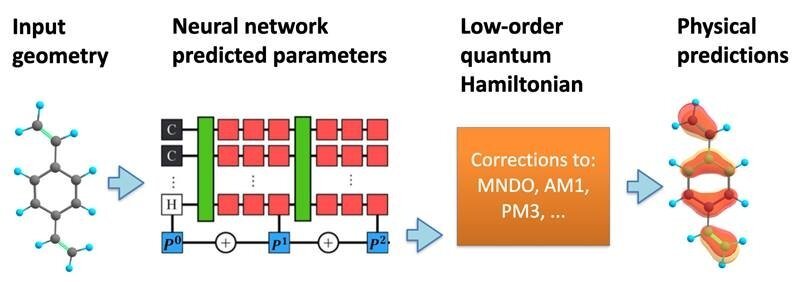The structure of the model. A neural network processes molecular geometry to predict a semi-empirical quantum Hamiltonian, which is then self-consistently solved to predict a variety of chemical properties. Photo credit: Kipton Barros, Los Alamos National Laboratory.
In a new study published in Proceedings of the National Academy of SciencesLos Alamos National Laboratory researchers have suggested incorporating more of the mathematics of quantum mechanics into the structure of machine learning predictions. Given the specific positions of atoms within a molecule, the machine learning model predicts an effective Hamiltonian matrix that describes the different possible electronic states along with their associated energies.
Compared to traditional quantum chemistry simulations, the machine learning-based approach makes predictions with a greatly reduced computational effort. It enables quantitatively precise predictions of material properties, provides interpretable insights into the nature of chemical bonding between atoms, and can be used to predict other complex phenomena, such as how the system will respond to perturbations such as light-matter interactions. The technique also offers greatly improved accuracy compared to traditional machine learning models and shows achievements in portability, which is the model’s ability to make predictions well beyond the data that formed the basis of its training.
The equations of quantum mechanics provide a roadmap for predicting the properties of chemicals from basic scientific theories. However, these equations can quickly become prohibitively expensive in terms of computer time and power when used to predict behavior in large systems. Machine learning offers a promising approach to speed up such large-scale simulations. Using machine learning to predict chemical properties holds the potential for major technological advances, with applications ranging from clean energy to faster pharmaceutical drug design. This is a very active area of research, but most of the existing approaches use simple and heuristic approaches to the design of the machine learning models.
In their study, the researchers showed that machine learning models can mimic the basic structure of the fundamental laws of nature. It can be very difficult to directly simulate these laws. The machine learning approach enables predictions that are easy to compute and accurate in a variety of chemical systems.
The improved machine learning model can quickly and accurately predict a variety of properties of molecules. These approaches perform very well on key computational chemistry benchmarks and show how deep learning methods can be further improved by incorporating more data from experiments. The model can also be successful at challenging tasks such as predicting excited-state dynamics – how systems behave at elevated energy levels. This tool is a breakthrough capability for quantum chemistry. It will allow researchers to better understand the reactivity and excited states of new molecules.
Computers excel in chemistry classes
Guoqing Zhou et al, Deep Learning Dynamically Responding Chemical Hamiltonians Using Semiempirical Quantum Mechanics, Proceedings of the National Academy of Sciences (2022). DOI: 10.1073/pnas.2120333119
Provided by the US Department of Energy
Citation: Breakthrough reported in machine learning-enhanced quantum chemistry (2022, September 13), retrieved September 13, 2022 from https://phys.org/news/2022-09-breakthrough-machine-learning-enhanced-quantum-chemistry .html
This document is protected by copyright. Except for fair trade for the purpose of private study or research, no part may be reproduced without written permission. The content is for informational purposes only.

